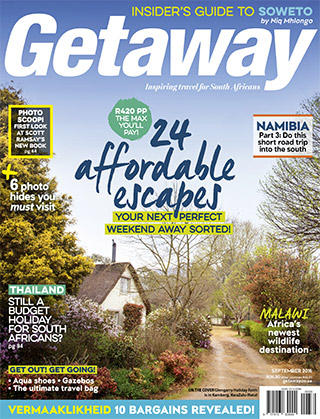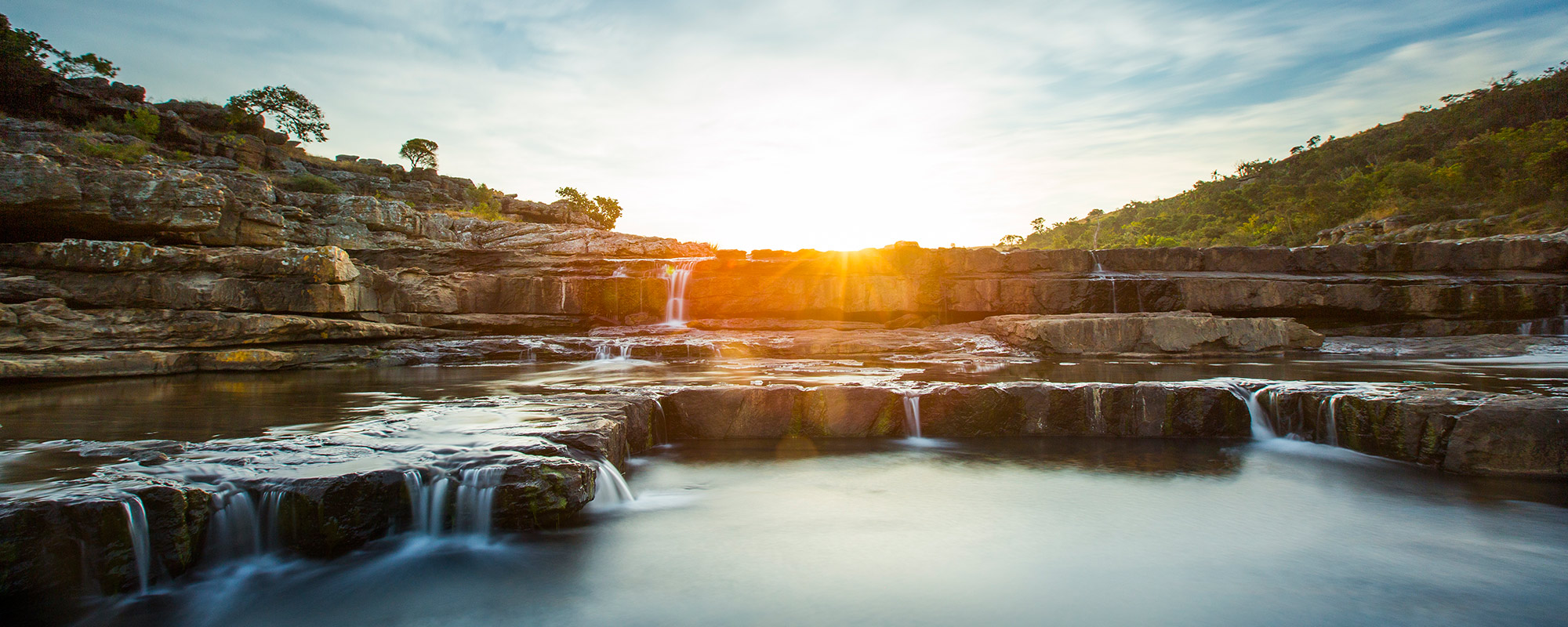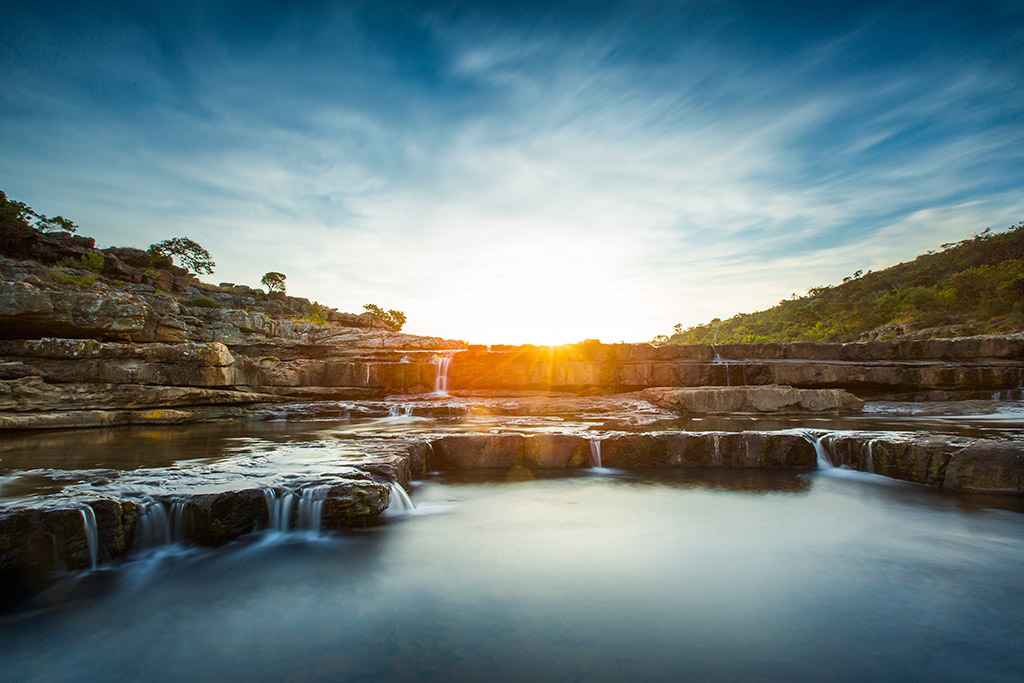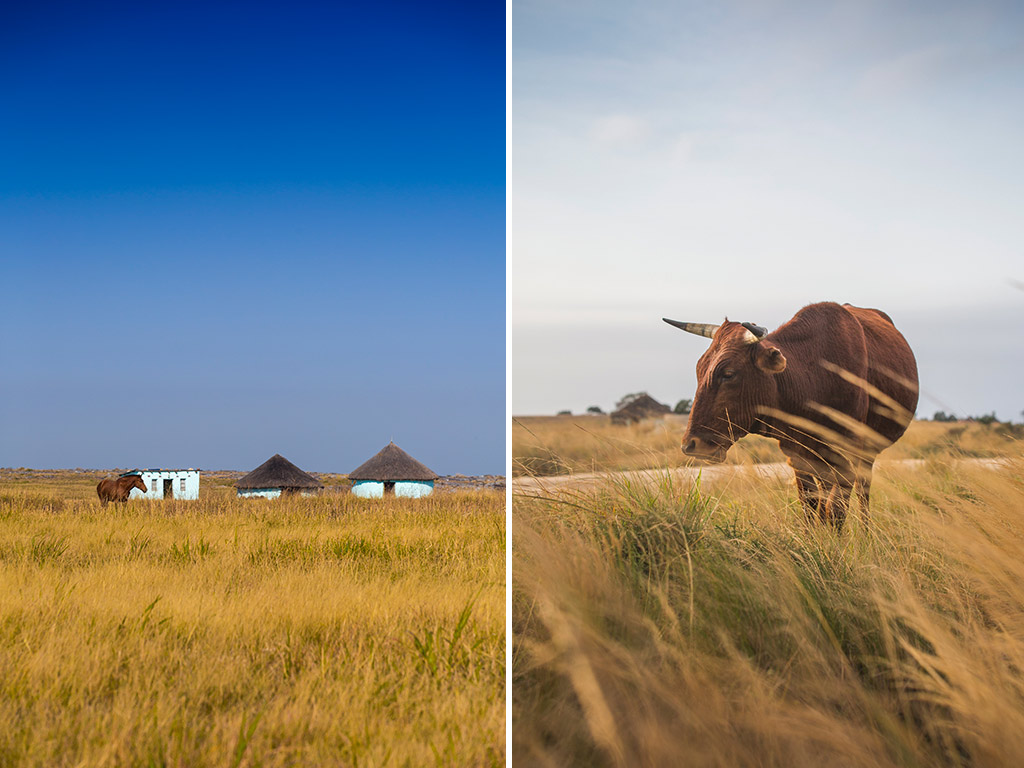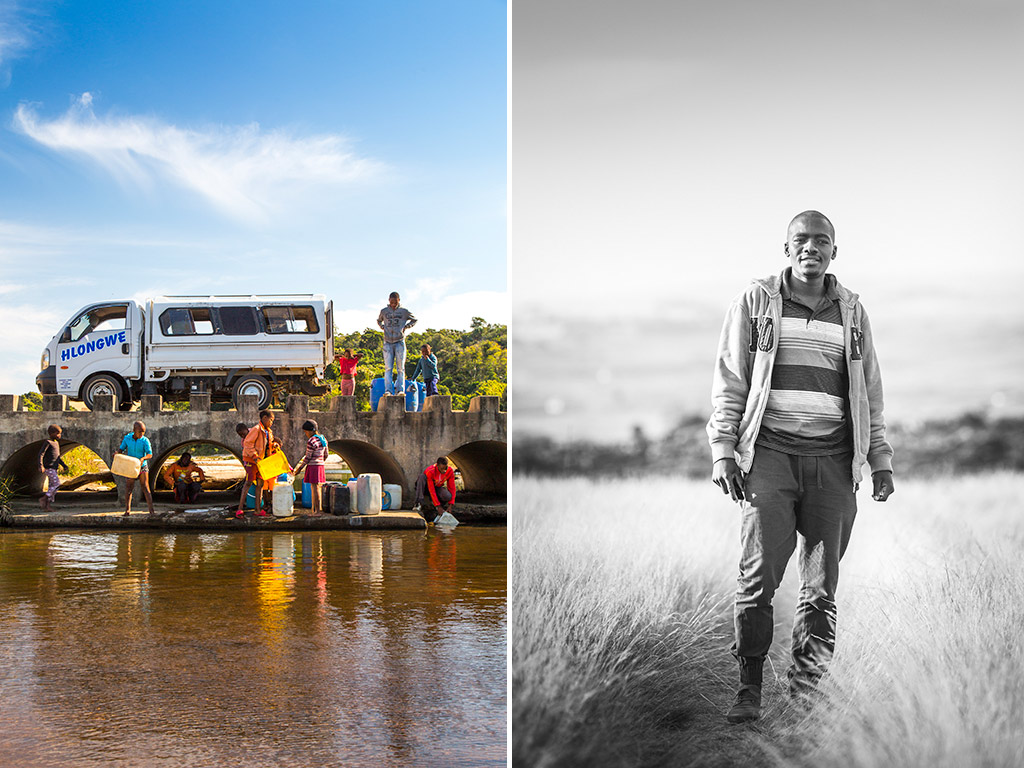Waterfalls, abundant rivers, indigenous forests and red dunes – Niq Mhlongo fell in love with Xolobeni’s wild and ancient beauty. Photographs by Teagan Cunniffe.
At first glance, as I slowly guide the Renault Captur to Xolobeni, I’m not convinced about the beauty I’m soon to discover about this place. The cold, foggy July morning has made it impossible to recognise and appreciate the untamed beauty that lies ahead. The golden brown grasslands look barren, dotted with nondescript shrubs and bushes and randomly scattered mud huts and modern houses. It’s only after I introduced myself to Richard Hlongwe, who teaches English at the local Xolobeni Primary School that I’m able to begin uncovering the mystique of the area.
‘We can only talk for few minutes. I have to fetch water down by the river for the construction of my house. We don’t have water in the yards, as you can see. After that I have a trip to Bizana with my guruguru,’ he points at the white Kia van parked close by.
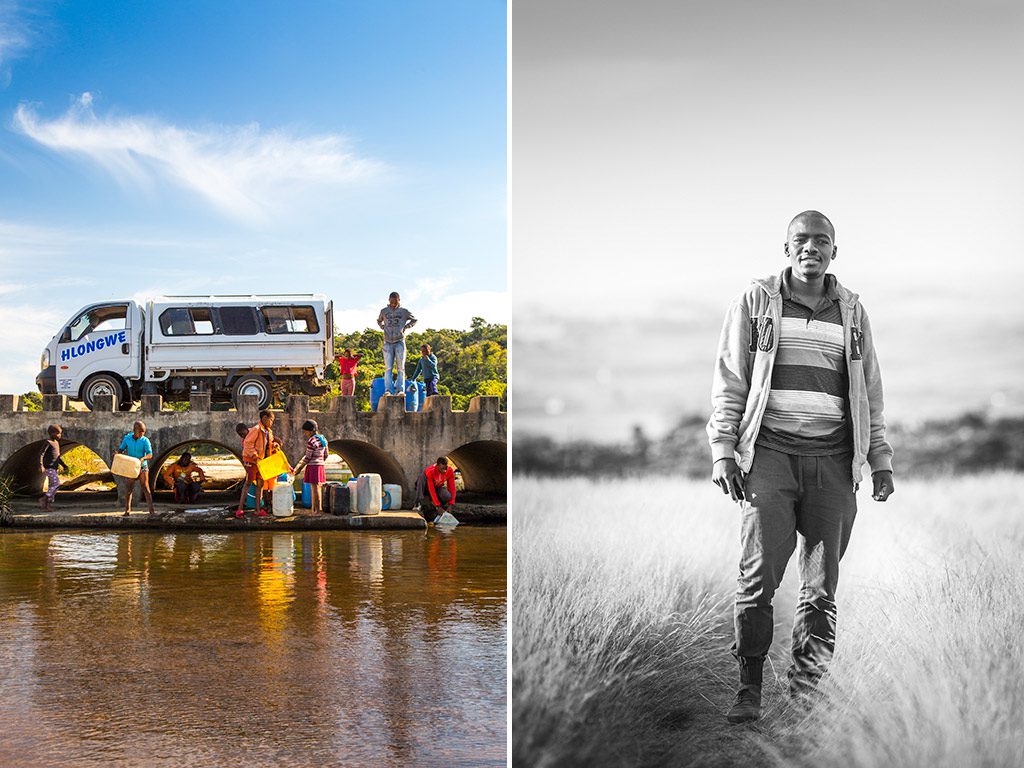
LEFT: Richard Hlongwe and his family drawing water from the Mnyameni River, not far from his home in Mtolani village. RIGHT: Richard Hlongwe, a teacher at the Xolobeni Primary School and my reliable guide.
I had been introduced to Richard just an hour ago by the Qaphela shopkeeper where I’d stopped to buy a drink. Richard is doubtful about the interview, but I assure him that it’s not about politics. This loosens him up a bit. There’s been a tense atmosphere in the village since Australian mining company MRC’s proposed mining of titanium in the area. The company has since pulled out, but the proposal to mine the ore lives on. All of it has sparked controversy and violence, and people’s faces are full of fear and mistrust. As we talk inside the car the sun rises with a sickly yellow lustre and clambers a few degrees above the ocean. It emits no decisive light, but introduces my eyes to the wonderful scene of the red sand dunes for the first time.
‘I was born over there, not very far from the dunes. We moved here a few years ago,’ he says, indicating his house. ‘Come tomorrow, and we’ll drive there. We used to ride bicycles along the dunes.’
As I drive back to Port Edward where I’m staying, my mind replays our conversation that lasted for over an hour. Only people like him who can afford green ‘jojo’ water tanks behind their houses can store rainwater. Everyone else draws water from the river. Only a few houses are electrified, as they can’t afford a solar system that costs between R1500 and R2000. The small solar panels I’ve seen on a few of the houses are rented at R60 per month and can only connect to certain kinds of television sets. Besides all this, I feel a sense of satisfaction and completeness about these villages.
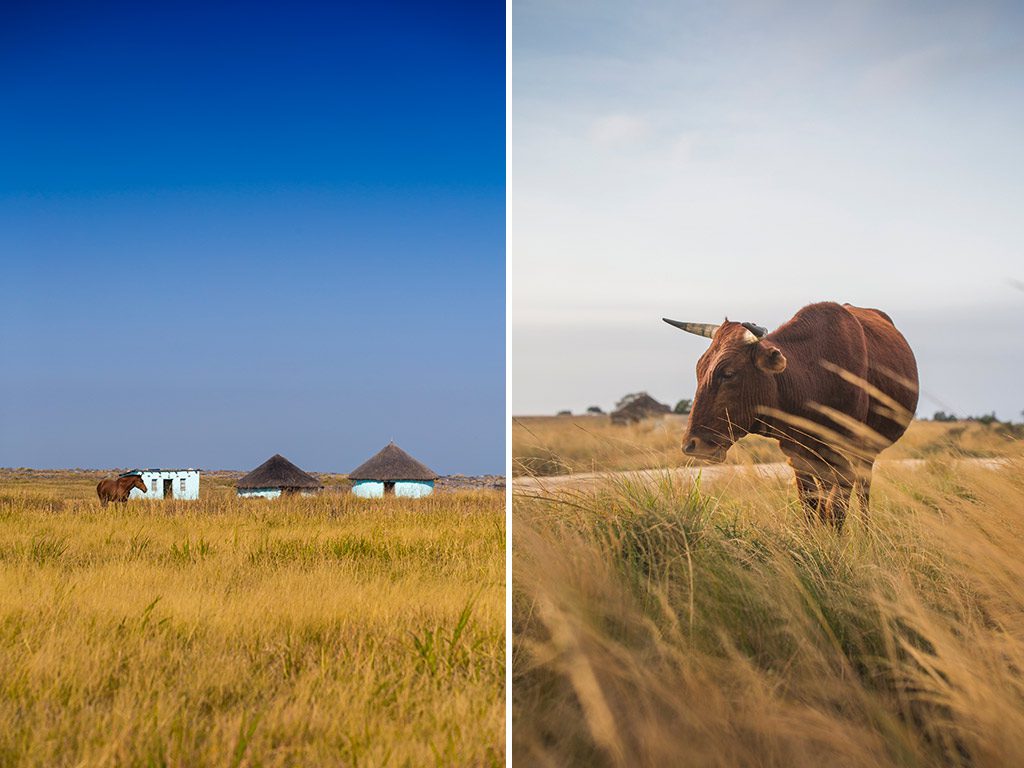
LEFT: Nyavini village. RIGHT: Livestock is one of the most important sources of wealth in Xolobeni.
The second time I return to Xolobeni, the sun is nice and shiny. Richard is in great spirits, and our first drive is to the Mnyameni River, where there are caves and waterfalls. This is about five minutes from his house. Here, the three caves stand in front of us like ghosts of the buried centuries. Upon entering the first cave, a kind of superstitious feeling creeps into me. My soul is suddenly wrapped up in silent wonder as I toy with the idea of writing my next supernatural novel here. But my thoughts are interrupted by Richard, who tells me his dream to build a guest house by the caves. I think it’s a brilliant idea. The place has tourism potential but it’s easy for a tourist to miss these caves, as well as the waterfall. The conflict has made locals reluctant to reveal the beauty of Xolobeni to strangers, and if they do reveal it, they do so cautiously.
After about an hour we’re on our way to the red sand dunes. It’s not a comfortable trip, and it takes a long time because of the bad road. In fact, to call this a road is to unnecessarily dignify a winding track that runs through the grass, connecting one household with another.
‘We used to swim at the Kwanyana Estuary and Isikhombe River, and before I became a teacher I worked at the Campsite Lodge next to the river. It’s now closed due to the mining conflict. What this place needs are basic services such as water, proper roads and a clinic, not mines. The only clinic is at Mgungu and it’s far. The nearest towns to buy basics are Bizana and Port Shepstone. People pay R30 for a single trip to get there.’ Halfway towards the dunes a trailer is stuck, making it impossible for us to continue. We are sadly forced to make a U-turn, and as we do so a man called Mr Jali appears. He’s a traditional healer in Xolobeni and knows a lot about the endemic plants in the area.
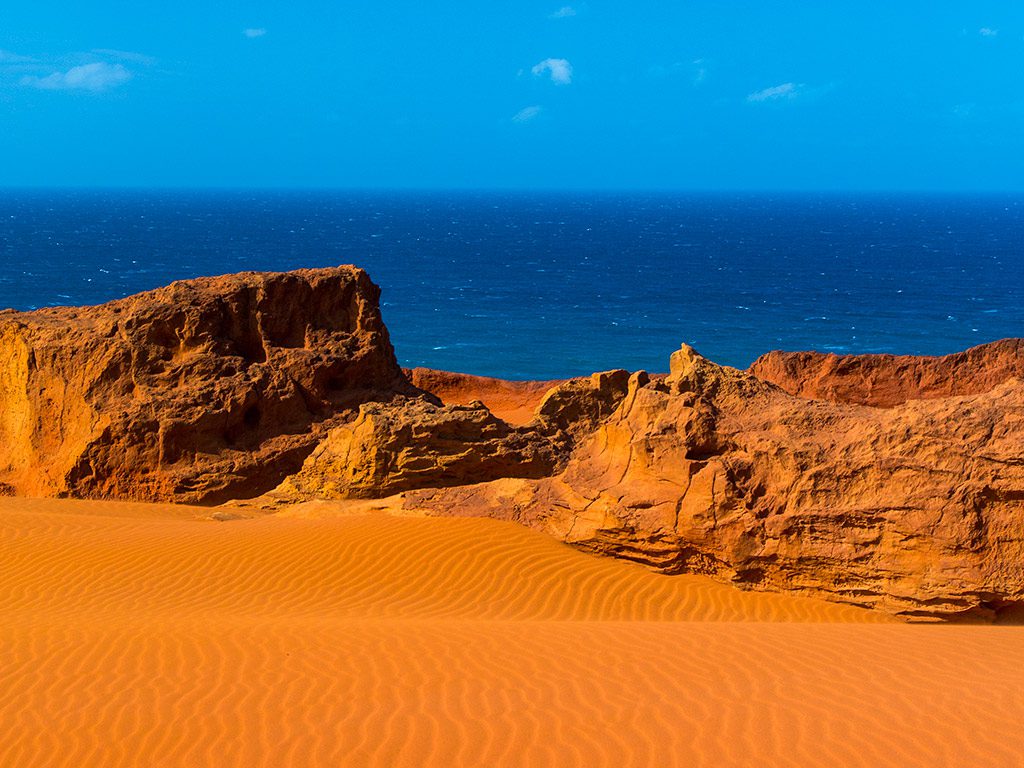
The isikhombe red desert.
‘This is umhlondlo and we use it for stomach aches,’ he points at the creeping plant with a leaf of two colours. ‘And this is a bhulu plant to trap the lightning.’ As we drive back, Mr Jali tells me to contact him should I experience any problem in life, including infertility. Through him I learn that the majority of people here may be poor and surviving on little, but are happy with their traditional way of life. Our day ends at the most captivating place of Xolobeni, the magical waterfalls. We can’t get enough of the breathtaking scenery of the Mnyameni River plunging over jagged cliffs.
The following afternoon we arrive at Mtentu Lodge. The wind blows fresh in our faces, and the atmosphere is pleasantly heavy with the scent of flowers and plants as we get out of the car. The ocean casts a kind of dreamy beauty, looking like the foundation of the universe. We are lucky that Russel Hartshorne, one of the partners of the lodge, is around to share his experiences of the area with us. He tells us how it’s frequented by people from all walks of life, hikers, cyclists and outdoor enthusiasts. Like many villagers, his concern is that the mining conflict divides this peaceful community and threatens the natural beauty that I’ve already fallen in love with.
An hour later, our host Dorcas Rattray begs me to take a solar shower. ‘I’m not implying that you’re dirty, but I want you to have the full experience of this beautiful place. If you do decide to, make sure it’s before 4.30pm.’ At 3.30pm I take the solar shower, and the experience is very refreshing. The water is nice and warm and the shower faces the scenic ocean below. After that we explore the area, walking past the campsite to the Mtentu Estuary. There are a few people at the beach, and some are hiking towards the Mkhambathi Nature Reserve across the river mouth. Before sunset we head back to the estuary again, and the incoming tide has by now covered most of the beach. A man is pushing a rowing boat with kids inside, and the sunset is spectacular as it reflects on the water.
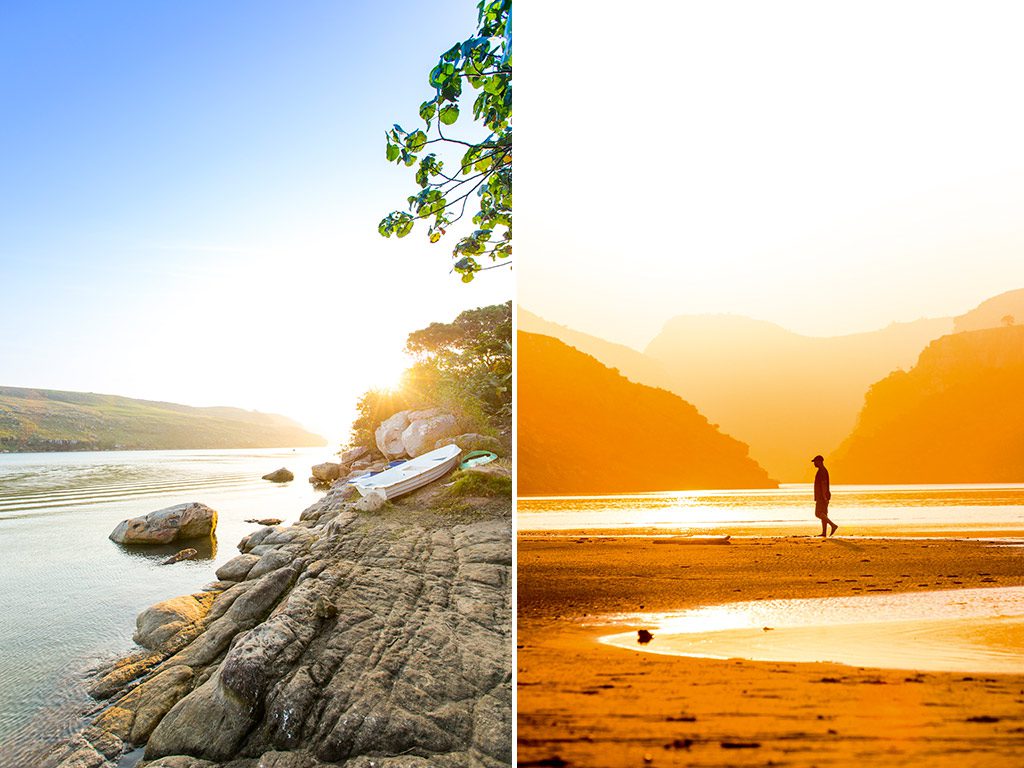
LEFT: At Mtentu River estuary. RIGHT: Taking a sunset stroll as the tide comes in at the Mtentu River estuary.
The next day we start out at six in the morning; our appointment with Richard is at 9am. The trailer that was stuck there is gone now, and we’re able to negotiate our way between the brown grass, amadumbe fields and cattle kraals until we reach the Isikhombe red dunes. The Kwanyana Estuary looks beautiful as it snakes towards the Indian Ocean.
‘This is where I was born, next to those houses. I will introduce you to my relatives later,’ says Richard, pointing to some dwellings nearby. The red soil on the dunes is partly sandy and partly hard, and mixed with black particles. As I stand there and examine it, a feeling for which I have no name takes possession of my soul. To me the whole area seems like a seduced and jilted lover that has just said no to a forced marriage with a foreigner for the sake of retaining her beautiful identity. My soul wants to save the dunes from the abstract nature of that forced intimacy.
Richard scoops up a handful of sand. He tells us that the black particles may be the titanium that the mining companies want to explore.
‘You see, most people here know nothing about mining and what change it’s going to bring. The majority is not skilled. They think the mining company will bring their own skilled labourers and leave the community to suffer. These are free grazing lands for our cattle, goats and sheep. The mining means our grazing land is taken away, and people here depend on livestock.’
Richard’s words sink in and make me think of a superstition about the dunes that was tucked away in my mind. This area has been the centre of conflict dating back to the Mfecane era. According to popular legend, the red sands became exposed as a result of the more than 30000 cattle that were held there during the 1820s, after King Shaka’s warriors captured them from the AmaMpondo. Some people believed that the hooves of the captured cattle beat the ground and scarred the red earth permanently. I look at the dunes with admiration, and a catalogue of memories and emotions run through me.
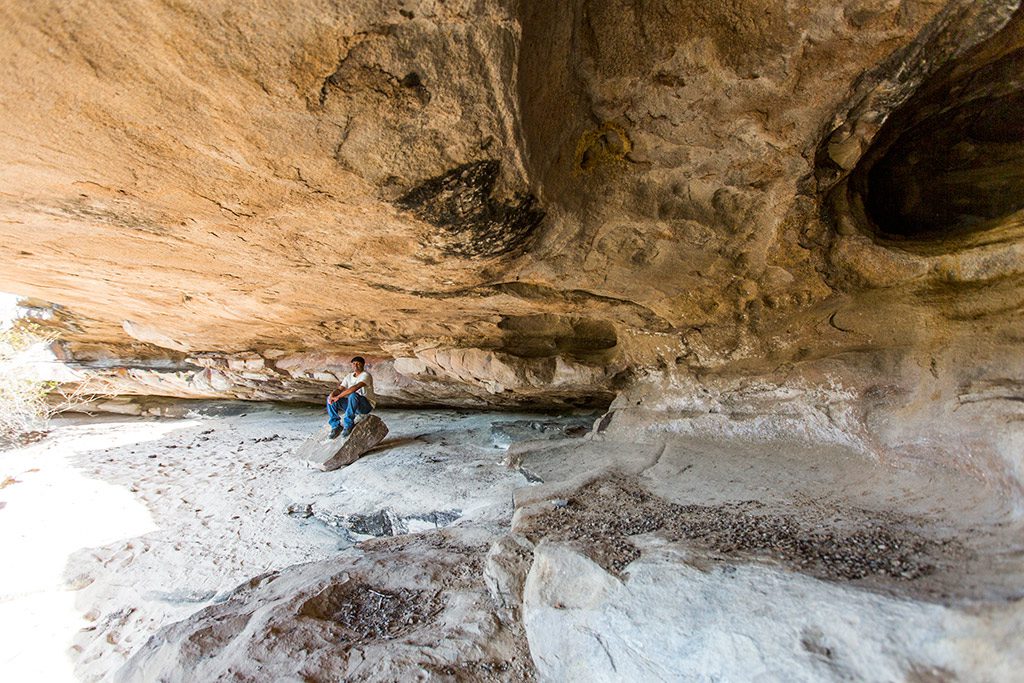
Inside one of the caves close to the Mtentu River.
One is this: growing up in the landlocked township of Soweto, one of my dreams was to visit the sea one day. When I first saw it in Durban in 1993, I sat down on the beach and admired it for hours. For me it was something I could do every day, just sitting and looking at the beauty of the ocean. I remember being surprised at the locals’ lack of appreciation of the sea. Then I realised that when an amazing burst of radiance is right in front of you all the time, you may be blinded by a sense of familiarity. This is exactly what I think may be the case with the people of Xolobeni. They live in this beauty every day; perhaps they don’t recognise it. And yet, strange as it may sound, to me the mining talk has also made the community become aware of the value of their land. That’s why people like Richard want to reclaim part of it now, while it’s still possible to do so. Otherwise, he’ll be left out when the tourism boom finally comes.
As I say goodbye to Xolobeni, I think I now understand why as a young boy in Soweto I used to like Miriam Makeba’s song called Amampondo. Being in this part of the Wild Coast is like an escape to a larger, freer society than any I have yet seen. It’s like time travel to a deeper and more comprehending love and beauty than any I’ve yet known. I feel lucky to have accessed the wholeness of this natural beauty, tradition and rich history of the AmaMpondo before it changes forever.

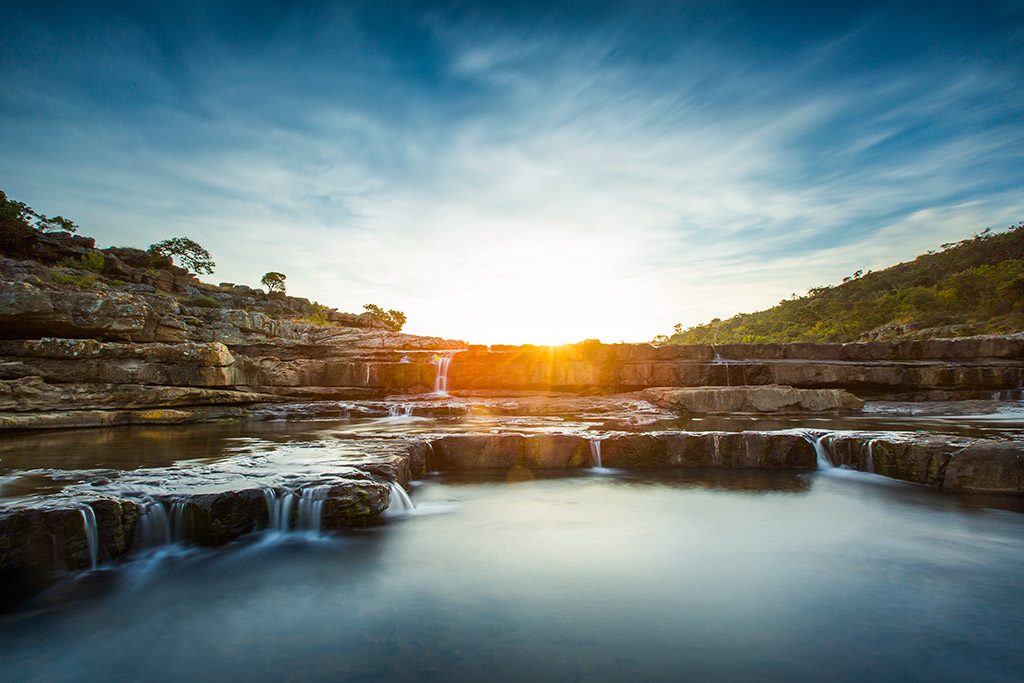
The waterfalls (ingxangxasi), one of the captivating charms of Mnyameni River.
Plan your trip
Getting there
Xolobeni is 130 kilometres south of Port Edward, but because of road works on the R61 and the bad gravel road to the coast, expect a long journey. A 4×4 is best. Take the R61 from Port Edward to Bizana past Wild Coast Sun. Turn left at Bhekela village. The gravel road will take you towards the ocean, and you’ll know you’re in the Xolobeni district when you see the village with red dunes behind it.
When to go
The best time to visit is from March to July when there is no rain to turn gravel roads into mud tracks, and it’s not too hot.
What it costs
Our trip cost around R8000 for the week for two people, including accommodation, food and car hire. There are cheaper places to stay than Mtentu Lodge, but it’s the most charming.
Need to know
Xolobeni is without water or electricity and most parts, including Mtentu Lodge, have no cell-phone reception. There are no big shops or fuel stations, so fill up and buy food beforehand at Port Edward or Bizana, and carry cash. Driving at night is not advisable as there are cattle, goats and sheep on the road. No fishing is allowed in the Mtentu River.
Things to do in Xolobeni
Hike in the Mkhambathi Nature Reserve, which has beautiful pockets of indigenous forest and a waterfall that falls directly into the ocean. You can also see game such as eland and zebra. The entry fee is R20 per person. You can do this with a guide from Mtentu Lodge for R50 per person. visiteasterncape.co.za, mtentulodge.co.za
The following activities below can all be booked through Mtentu Lodge:
Canoe up the Mtentu River and see the three waterfalls. The river is well known for its kingfish, which you can see between December and February, as well as loggerhead turtles and otters. To see the first two waterfalls, you can simply hire a boat (for three) and paddle up. The third waterfall, Swallowtail, requires more of a hike and a guide, but it’s spectacular (it takes half a day). Boat hire is R50, while the full hike costs R60 per person.
Ride a horse from the Wild Coast Sun to the Mtentu River estuary (about 24 kilometres) passing six villages. This is done in partnership with local villagers. From R500 per person.
Do the five-day Amadiba Explorer hike, staying over in villages and sleeping like the locals, in rondavels on the floor. It costs R4 500 per person.
Visit the waterfall at the Mnyameni River with a local guide. It costs from R350 for a group of 10 people, plus another R350 for more.
Places to stay near Xolobeni
Mtentu Lodge has gorgeous views and six cabins linked via wooden walkways. From R700 per cabin (sleeps four) and R100 per person camping. mtentulodge.co.za
Port Edward Holiday Resort has chalets that sleep two to four. From R730 per chalet. portedward.co.za
Mtentu Homestay is Siyabonga Ndovela’s beautifully kept, traditional Pondo home overlooking the Mkhambathi Reserve. R350 per person including meals. 0710084989 (or book via Mtentu Lodge).
Eat here
Mtentu Lodge offers breakfast, lunch and supper for R300 per person per day. It will provide packed lunches/picnics on request and caters for vegetarians. Tea and coffee are free. 0838053356, mtentulodge.co.za
Beach Bobbies Cocktail Bar & Restaurant in Port Edward caters for a wide range of appetites; the menu has steak and chips (from R63), seafood and pizzas (up to R55). 0393112333, portedward.co.za
For more information about how potentially harmful and unsustainable practices on the Wild Coast are evaluated and challenged, visit swc.org.za.
This story first appeared in the September 2016 issue of Getaway magazine.
Our September issue features affordable destinations around SA, great photographic hides, and a Thailand travel guide. On shelves from 22 August.
